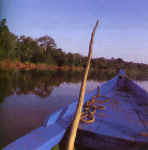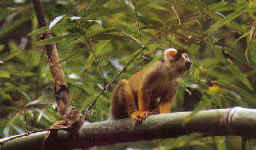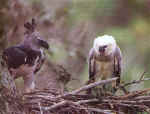|
|
![]()
Conservation and the risks of oil exploration in the Candamo Valley as according to Conservation International.
![]()
 After the Peruvian Government gave the green light for oil exploration in
part of the Tambopata-Candamo Reserve, in the department of Madre de Dios, a
team from the technical co-operation agency, Conservation International (CI),
decided to study the area's flora and fauna and find ways to minimise the impact
of industrial activity.
After the Peruvian Government gave the green light for oil exploration in
part of the Tambopata-Candamo Reserve, in the department of Madre de Dios, a
team from the technical co-operation agency, Conservation International (CI),
decided to study the area's flora and fauna and find ways to minimise the impact
of industrial activity.
The study, which got underway in October 1996, revealed several unique dimensions of the Candamo Valley. CI proposed a set of guidelines to industrial companies (especially in the hydrocarbons sector) for taking into account the environment, the importance of ecosystems, and when they should respect protected natural areas in the course of their work.
 Relations between CI and Mobil began in 1995, two years after the company
closed an agreement with the Peruvian government to evaluate the potential for
hydrocarbons production in Madre de Dios. CI supported the process that led to
the Government's decision in July 1996 to rule out the Bahuaja-Sonene National
Park for exploration. However, because of its interest in developing the country’s
hydrocarbons resources, the protected area that the Government ultimately
approved was much smaller than intended in the original proposal.
Relations between CI and Mobil began in 1995, two years after the company
closed an agreement with the Peruvian government to evaluate the potential for
hydrocarbons production in Madre de Dios. CI supported the process that led to
the Government's decision in July 1996 to rule out the Bahuaja-Sonene National
Park for exploration. However, because of its interest in developing the country’s
hydrocarbons resources, the protected area that the Government ultimately
approved was much smaller than intended in the original proposal.
Between 1996 and 1997, researchers and social workers involved in the "Environmental and Social Impact Assessment" (EISA) evaluated the areas immediately around the exploration zone. Their job was to collect data and occasionally inform the local communities about what hydrocarbons exploration generally involved.
Some of their environmental recommendations were incorporated and implemented in the company's plans for the area.
 The area known as ‘The Cloud’ is a vulnerable and uncharted ecosystem,
located in the tropical forests of southeast Peru, in the centre of the Candamo
River Valley. It is home to the country's highest concentration of biodiversity.
Prior to the EISA project there was no information on this area of the valley.
The area appears as a white patch on Mobil’s satellite – ‘The Cloud’
never parted. The area’s virtual inaccessibility, ensured by a forbidding
terrain full of cliffs and hills, had made earlier research impossible. The EISA
team was only able to carry out its task by hitching rides on the helicopters
used by Mobil to ferry its exploration crews in and out of the zone. The CI
team, made up of Peruvian and US researchers, is busy gathering data on the area
and developing feasible recommendations to prevent the ecosystem and its
biodiversity from being jeopardized.
The area known as ‘The Cloud’ is a vulnerable and uncharted ecosystem,
located in the tropical forests of southeast Peru, in the centre of the Candamo
River Valley. It is home to the country's highest concentration of biodiversity.
Prior to the EISA project there was no information on this area of the valley.
The area appears as a white patch on Mobil’s satellite – ‘The Cloud’
never parted. The area’s virtual inaccessibility, ensured by a forbidding
terrain full of cliffs and hills, had made earlier research impossible. The EISA
team was only able to carry out its task by hitching rides on the helicopters
used by Mobil to ferry its exploration crews in and out of the zone. The CI
team, made up of Peruvian and US researchers, is busy gathering data on the area
and developing feasible recommendations to prevent the ecosystem and its
biodiversity from being jeopardized.
While CI has suggested alternatives to mitigate the environmental effects of oil industry activities, its real goal is for the area to be reincorporated into the Bahuaja Sonene National Park. In other words, it is trying to safeguard the Candamo Valley's environmental health so that it can be returned to the Bahuaja Sonene National Park in its original pristine state.
![]()
By Jacqueline Fowks
Volume /Issue 15, Page 03
[Top of Page] ![]() http://www.rumbosperu.com
http://www.rumbosperu.com